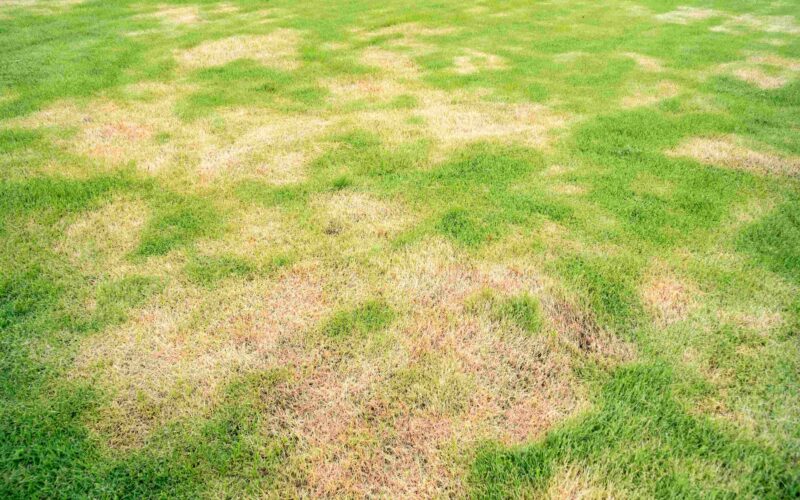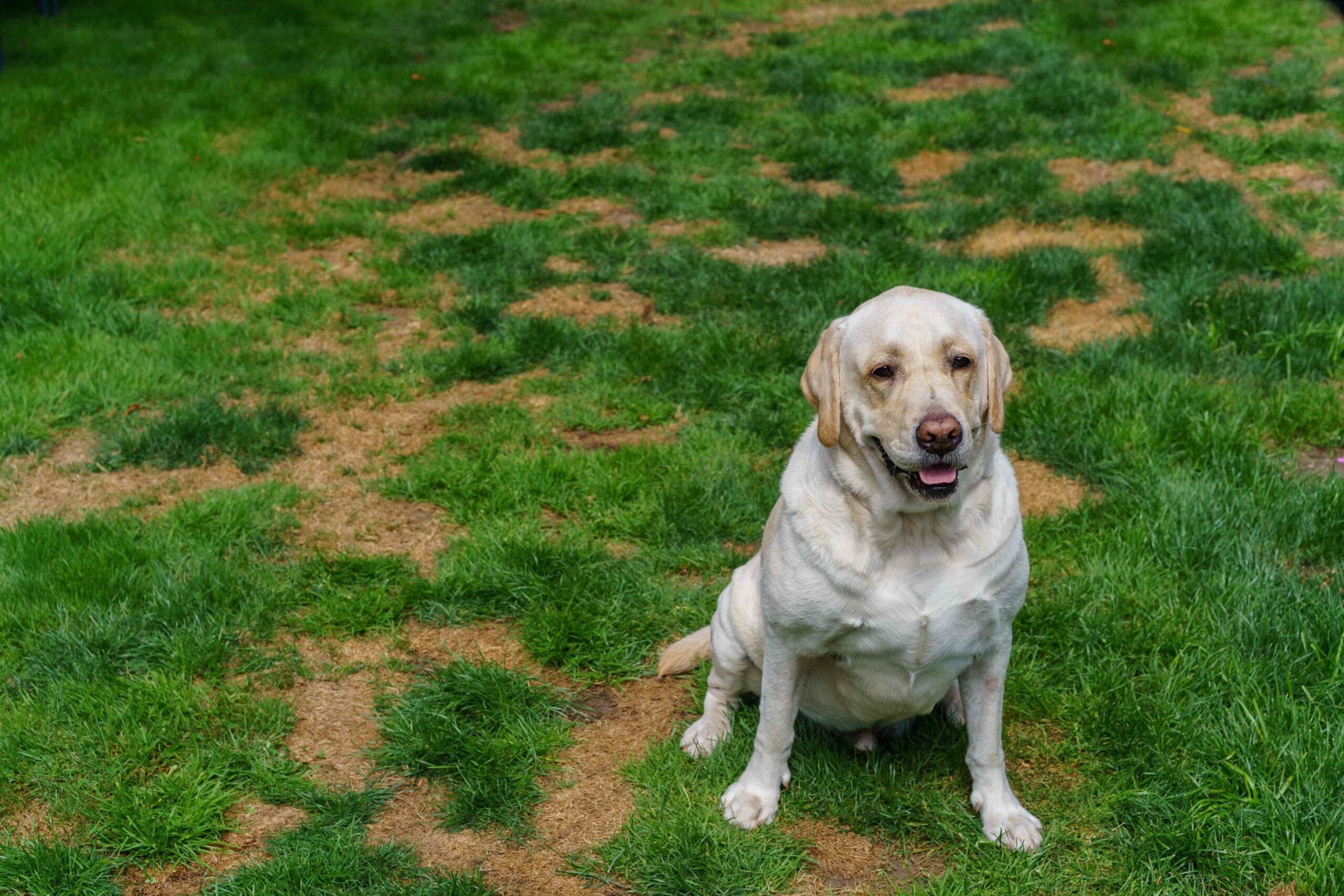Step-by-Step Guide on How to Fix Dead Spots in Lawn

With a lush carpet of grass, your lawn will be the envy of the neighborhood. Unfortunately, getting the perfect green is difficult for a lot of people. If you feel like patches and dead spots are the bane of your existence, don’t worry! We’ll teach you common causes of brown patches and how to fix dead spots in your lawn.
Dead Grass vs. Dormant Grass
Before you give up on your brown spots, you need to understand the difference between dead grass vs. dormant grass. To protect itself and conserve nutrients, dormant grass temporarily stops growing during periods of high heat, cold, or drought. It can remain dormant for several weeks, but the roots are still alive!
Dormant grass is characterized by its flexibility. It looks brown and dry, but the blade will bend when touched. Dead grass, on the other hand, is brown, dry, and brittle. Once the root has died, it’s beyond saving.
To check for yourself, use the pull test. Dead grass will come up easily when you pull on it. Grass that is rooted will not.
What Causes Dead Spots?
There are many dead grass causes. These include human and animal problems, poor growing conditions, or lawn diseases and pests. It’s important to identify the cause so it won’t keep happening after you patch the area.
1. Fungal Diseases
Fungal diseases can develop because of rainy or humid weather, limited sunlight, or bad air circulation. They usually result in irregular brown patches around your lawn. Most diseases have a distinct look to help you identify them.
2. Animal Digging
Animal digging is another cause of dead spots. Wildlife may disrupt your grass looking for insects, leaving holes and bare patches in their wake.

3. Dog Urine
We love our pets, but your dog may be causing the dead spots in your yard. Dog urine is high in nitrogen, and when they use the bathroom in the same spot over and over, the nitrogen builds up, killing your grass. The dead patches will be brown with a dark green outer ring. To avoid this, make sure your dog relieves itself in different places each time.
4. Grub Damage
Grubs cause damage by eating the roots of your grass, resulting in dead spots that are fairly uniform and sponge-like. You can prevent this with grub-control products, such as Bonide Insect & Grub Control.
5. Dull Mower Blades
Another potential dead grass cause is your mower. Dull blades will tear up your grass instead of cutting it. Tearing it up or even cutting it too short will cause the grass to die. Avoid this by sharpening your mower blades periodically.
6. Thatch
Thatch is an organic material that accumulates between the blades of grass and the root system. Thatch builds up when the turf can’t break down organic debris fast enough. A little thatch is healthy, but too much stops the flow of nutrients to your grass. If thatch reaches ½ inch thick, break it up with a thatch rake.
7. Heat and Drought
Heat and drought are other common culprits of dead patches in your yard. Remember to water your grass and follow the correct lawn care tips.
If you’re not sure about the cause in your own lawn, ask our expert team at your local Home & Garden Store and we can help!
How to Fix Dead Spots in Lawn
The best time for grass replanting is late summer and early fall. This is because grass seed germinates well in cooler, damper conditions. This allows the young roots to get off to a good start in soil that’s still reasonably warm. The grass now has six to seven months of root growth before hitting the summer heat.
Early spring is also a decent time to patch, but you need to pay more attention to watering as the weather gets hot and dry. Your young grass is more vulnerable to the harsh summer elements, so take good care of it as it grows.

1. Remove Dead Grass
The first step in learning how to fix dead spots in your lawn is to clear out brown grass and other debris like rocks and sticks. It’s also helpful to remove the top layer of soil. You can use different types of rakes for this step, including garden, hand, or thatch rakes.
2. Loosen the Soil
You can’t just toss seeds on hard ground! After you remove dead grass, you need to scratch the surface of the dirt with a rake. Or, even better, dig and loosen the top two to three inches to help the roots grow deeper. If your soil is especially poor, work in some compost or other organic matter to add extra nutrients. When you’re done, don’t forget to level the surface.
3. Scatter Grass Seed
Your next step is to plant grass seed. Choose your seed based on your current type of grass. Some general grass seed tips:
- Choose seeds right for your climate and yard’s sun exposure
- If you live in a dry area, find drought-resistant seeds
- Pick a seed that can withstand the amount of foot traffic your lawn receives
- Warm-season grass: grows best in hot weather and goes dormant in cool temperatures
- Cold-season grass: grows best in the spring and fall and turns brown during high heat
4. Lightly Scratch It In
The next step after you plant grass seed is to rake it in so it’s spread evenly across the dead patch. You want some of your seeds incorporated into the top quarter-inch of the soil and some at or near the surface. Lightly tamp it for good seed-to-soil contact.
5. Fertilize
This is an optional step for successful grass replanting to help jumpstart seed growth. Scatter a small amount of lawn fertilizer specifically made for new grass. Shop our fertilizer collection to get started.
6. Cover with Mulch
Top the dead patch with a light layer of straw of chopped leaves—just enough to cover the ground. This helps slow evaporation and increase moisture. It also discourages seed washout and improves germination.
7. Water
The last step is to lightly water your dead spot every day for about two weeks until the seeds germinate. Keep the area moist, but don’t drown it. Try to wet the top two inches of soil. After it grows to mowing height, begin watering deeply once or twice a week, rather than daily.
8. Continue Practicing Proper Lawn Care
Now that you know how to fix dead patches of grass, remember to keep caring for your lawn to avoid more dead grass in the future. Develop a plan and schedule to keep your yard green and healthy all year long!
With these tips on how to fix dead spots in your lawn, you’re ready to begin patching! Check out Stauffers Online Home & Garden offerings for all the supplies you need to get started.
This blog was originally published on July 11, 2013. It was updated on March 1, 2024.
